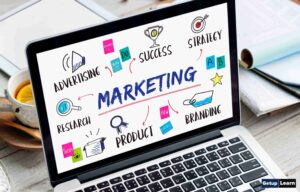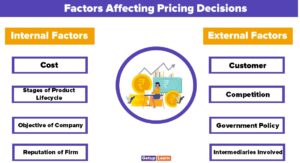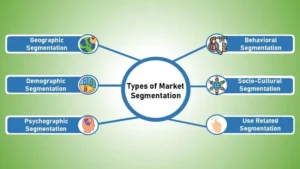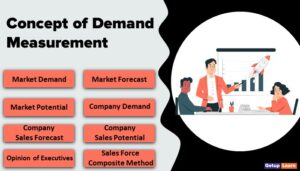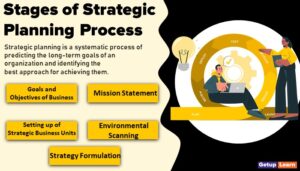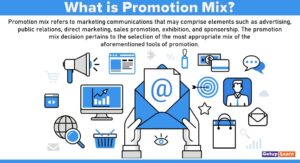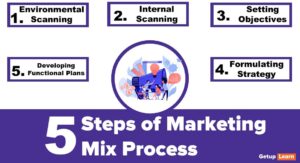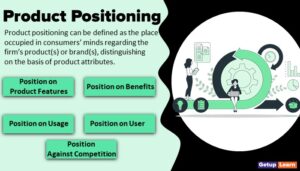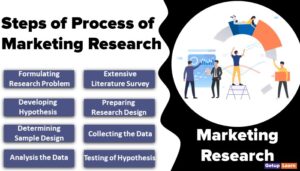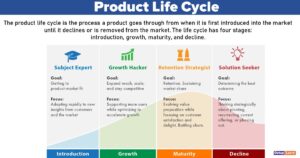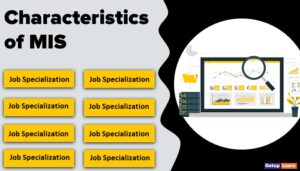Table of Contents
- 1 What is Business Market?
- 2 Types of Buying Situations
-
3 Characteristics of Business Markets
- 3.1 Fewer Buyers
- 3.2 Large Buyers
- 3.3 Supplier Customer Relationship
- 3.4 Geographically Concentrated Buyers
- 3.5 Derived Demand
- 3.6 Inelastic Demand
- 3.7 Fluctuating Demand
- 3.8 Professional Purchasing
- 3.9 Several Buying Influence
- 3.10 Multiple Sales Calls
- 3.11 Direct Purchasing
- 3.12 Reciprocity
- 3.13 Leasing
- 4 Difference Between Institutional and Government Markets
- 5 Difference Between Consumer Market and Business Market
- 6 Participants in Business Decisions
- 7 Stages of Buying Process in Organization
- 8 FAQ Related to Business Market
What is Business Market?
The Business Markets include organizations that buy products on large scale either for the production of another product or for their own use. Organizations are buyers as well as sellers.
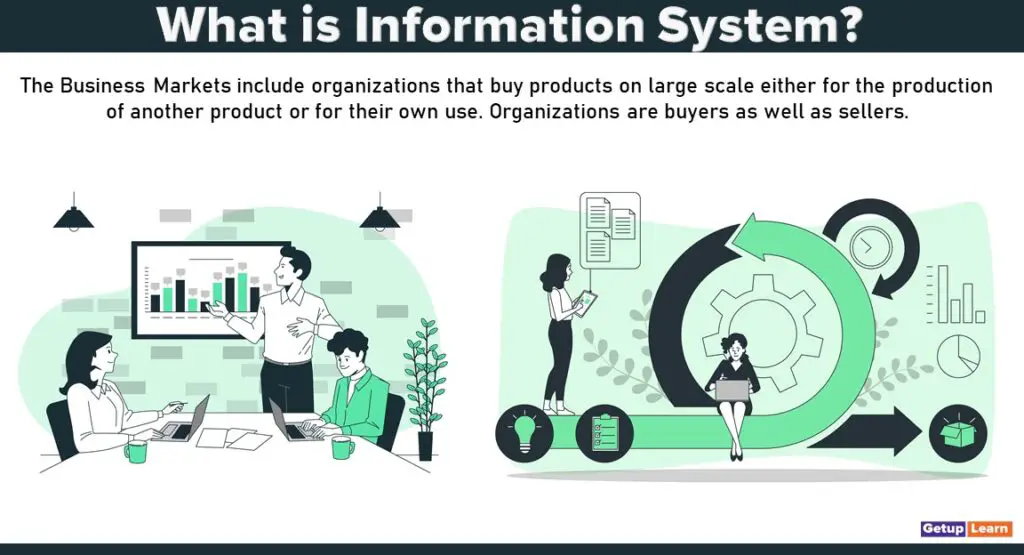
Buying for Producing for Consumers
Organizations buy products and add value to the same for selling to Consumers. These organizations are end users, buying products and services for their operations from suppliers. For example, an ice cream producer needs to buy materials to produce (milk, sugar, preservatives), to package (wood, paper) the ice cream bar for consumers.
Buying for Own Use
Organizations also buy products and services for their own consumption instead of adding value to them for selling. For example, air conditioners, stationary, insurance for the company and employees, etc. These also include wholesalers and retailers that acquire goods for reselling them at profit.
Types of Buying Situations
There are three major types of buying situations that are explained below:
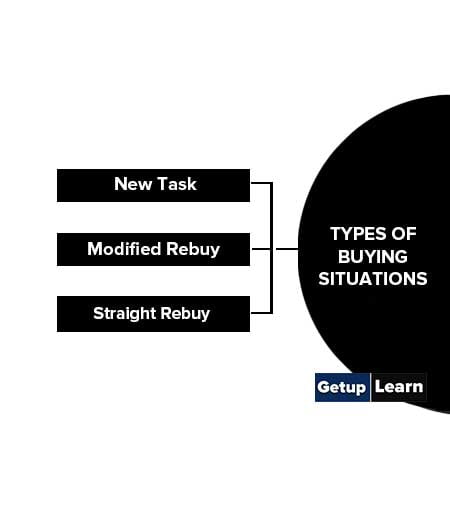
New Task
The purchase is done for the first time with no purchasing experience, and an extensive search is done to evaluate options. The expertise of decision–making in participants will be very crucial as there is great risk involved.
For example, for the first time, an organization buys chemicals to manufacture paints.
Modified Rebuy
Due to changes in preferences or entry of a substitute product in the market, organizations are forced to modify an existing product to suit the target market. The modifications can be changes in product characteristics, price, quality, suppliers, etc.
This process is less risky and less time-consuming as compared to the “New Task” buying situation as the information is gathered on alternatives.
For example, A school may purchase a bigger school bus to add to the existing fleet of minibusses. The supplier of the bigger bus is the same one who had earlier supplied minibusses to the school.
Straight Rebuy
In this buying, the organizations rebuy products and services from the same suppliers. Suppliers usually visit the organizations to take orders in advance to maintain their market share.
The people involved in the buying process have relatively good experience of buying and need no additional information on products and services. There is no risk involved because of past experience of purchasing the same products and services.
For example, A paint manufacturer who buys chemicals repeatedly from the same suppliers to meet the production demand will be a straight re-buy. In these cases, the specifications of the required chemicals, price, delivery period, etc., must remain the same.
Characteristics of Business Markets
Let’s discussed the characteristics of business markets in detail:
- Fewer Buyers
- Large Buyers
- Supplier Customer Relationship
- Geographically Concentrated Buyers
- Derived Demand
- Inelastic Demand
- Fluctuating Demand
- Professional Purchasing
- Several Buying Influence
- Multiple Sales Calls
- Direct Purchasing
- Reciprocity
- Leasing
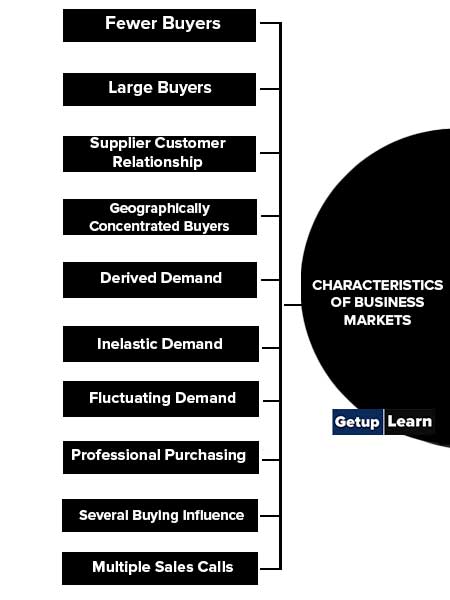
Fewer Buyers
Fewer Buyers: The business marketer normally deals with far fewer buyers than the consumer marketer does. For example, MRF Tyres largely depend on orders from Maruti Ltd and Honda.
Large Buyers
Large buyers: do most of the purchasing in such industries as aircraft engines and defense equipment.
Supplier Customer Relationship
Because of the smaller customer base and the importance and power of the larger customers, suppliers are frequently expected to customize their offerings to individual business needs. Sometimes the buyers require the sellers to even change their practices and performance.
Geographically Concentrated Buyers
A large group of business buyers in India is concentrated in major cities: Mumbai, Delhi, Kolkata, Chennai, Hyderabad, Pune, and Ahmedabad. The geographical concentration of producers helps vendors to focus and reduce selling costs.
Derived Demand
The demand for business goods is ultimately derived from the demand for consumer goods. For this reason, the business marketer must closely monitor the buying patterns of ultimate consumers.
Inelastic Demand
The total demand for many business goods and services is inelastic that is, not much affected by price changes. Shoe manufacturers do not buy more leather if the price of leather falls or vice versa. Demand is especially inelastic also because producers cannot make fast changes in production methods.
Fluctuating Demand
The demand for business goods and services tends to be more volatile than the demand for consumer goods and services. A small percentage increase in consumer demand can lead to a much larger percentage increase in the demand for plants and equipment necessary to produce the additional output.
Professional Purchasing
Business goods are purchased by trained purchasing agents, who have to follow the organization’s purchasing policies, limitations, and requirements.
Several Buying Influence
Purchasing committees consisting of technical experts and even senior management are common in the purchase of major goods. Vendor marketers have to send well–trained sales–representatives and often sales teams to deal with the well senior executives.
Multiple Sales Calls
Because more people are involved in the selling process it takes multiple sales calls to get business orders. On average, it takes more than four calls to close an average industrial sale.
In the case of capital equipment sales for large projects, it may take multiple attempts to fund a project, and the sales cycle between quoting for a job and final delivery of the product is often measured in a number of months.
Direct Purchasing
Business buyers often buy directly from manufacturers rather than through intermediaries, especially items that are technically complex or expensive.
Reciprocity
Business buyers often select suppliers who also buy from them. For example, a paper manufacturer will buy chemicals from a chemical company that buys a considerable amount of its paper.
Leasing
Many industrial buyers lease instead of buying heavy equipment like machinery and trucks. The lessee gains a number of advantages: conserving capital, getting the latest product, and receiving better service.
The lessor often ends up with a larger net income and the chance to sell to customers who could not afford the outright purchases.
Difference Between Institutional and Government Markets
The business–to–business market focuses on products, goods, and services that are typically sold to other businesses rather than direct to consumers. Examples include office furniture, corporate accounting services, and conference and exhibit supplies.
Many business–to–business markets have some overlap with consumer markets, for example, a cleaning company may provide both residential and commercial services.
Let’s understand the difference between institutional and government markets:
Institutional Markets
The institutional market consists of schools, colleges, hospitals, nursing homes, prisons, and other such institutions that must provide goods and services to people. Many of these organizations are characterized by low budgets and captive clientele.
For example, hospitals have to provide hygienic food for their patients. The buying objective is not profit, but part of the total service package. The objective is also not cost reduction because poor food will harm the patients and hurt the hospital’s reputation.
The hospital purchasing agent has to search for institutional food vendors whose quality meets a certain minimum standard. Many food vendors set up a separate division to sell to institutional buyers because of these buyers’ special needs and characteristics.
Thus, organizations will produce, package, and price their products differently to meet the different requirements of hospitals, colleges, and prisons.
Government Markets
In most countries, government organizations are major buyers of goods and services. Government organizations typically require suppliers to submit bids and award the contract generally to the lowest bidder.
Governments will also buy on a negotiated contract basis, primarily in the case of complex projects involving major R & D costs and risks and in cases where there is little competition. Government organizations tend to favor domestic supplies over foreign suppliers.
A major complaint of multinationals operating in Europe was that each country was favoring its nationals in spite of superior offers that were available from foreign firms.
As their spending decisions are subject to public review, government organizations require considerable paperwork from suppliers, who often complain about excessive paperwork, bureaucracy, regulations, decision–making delays, and frequent shifts in procurement personnel.
Difference Between Consumer Market and Business Market
Let’s discuss the difference between consumer market and business market:
- Fewer Buyers
- Close Supplier-Customer Relationship
- Geographically Concentrated Buyers
- Derived Demand
- Inelastic Demand
- Professional Purchasing
- Direct Purchasing
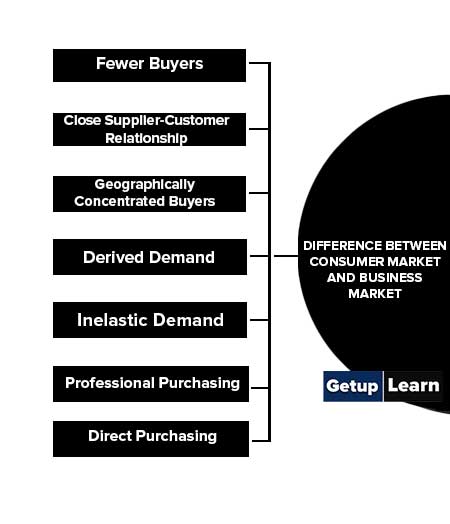
Fewer Buyers
In the case of the business market, buyers are fewer in number as compared to the consumer market. For example, a book publisher looks toward universities for recommendations for its books, but after recommendations sell the same to the students who are thousands in numbers.
Close Supplier-Customer Relationship
There is a smaller customer base but having important power, we can observe that there is a close relationship between the two parties because the customer is heavily dependent upon the supplier.
It is expected of a supplier that he would offer customized service and will pay regular visits to the customer. If it is the case of a technical product, he would make special efforts to impart the technical know-how to the customer.
Geographically Concentrated Buyers
Most of the business concerns that produce the same nature of products are generally found concentrated in a particular geographic area. This kind of concentration helps producers to reduce a certain amount of selling costs.
Availability of raw materials and transportation help them reduce costs. For example, more than half of the textile industries in India are concentrated in two states only i.e. Gujarat and Maharashtra. Most agricultural inputs are produced in the states like Punjab and Haryana.
Derived Demand
The demand for organizational products is called derived demand because organizations purchase products to be used directly or indirectly in the production of goods and services to satisfy consumers’ demand. Consequently, the demand for organizational products is derived from the demand for consumer products.
For example, as long as consumers continue to purchase pencils, there will be an organizational demand for graphite and wood to manufacture pencils. If there were no consumer demand for pencils, there would be no demand for wood and graphite to make pencils.
As a result, organizations like wood manufacturers often target marketing efforts at the ultimate consumers, even though the firms don’t sell to them directly.
Inelastic Demand
The demand for many organizational products is inelastic. It means that fluctuations in the price of a product will not significantly affect demand for the product. Elastic demand, by contrast, means that a change in price will cause an opposite change in demand.
However, a sizeable price increase for a particular component that represents a large proportion of a product’s cost may cause demand to become more elastic if the price increase of the component part causes the price of the consumer product to rise sharply.
For example, if the price of wood rises sharply, paper manufacturers are likely to pass this increase on to consumers, who may in turn cut back on their paper consumption because of such an increase.
Professional Purchasing
The business products are generally purchased by highly trained and professional people. They invite biddings, proposals, and quotations for their purchase contracts which are not found in the case of consumer buying.
Direct Purchasing
When it comes to consumer buying, many intermediaries are involved but in the case of business buying, buyers generally buy directly from the manufacturers.
It is truer if it is a case of a technical product that is complex as well as expensive. So, there are some examples of differentiation between a business purchase and a consumer purchase.
Participants in Business Decisions
Business purchase decisions are hardly made by just one person. Instead, most organizations make their purchase decisions through many individuals who work in the organization and also participate in the purchase decision process.
Following are the participants in business decisions:

Users
These are those individuals who actually use the product in the organization. They frequently initiate the purchase process, establish the criteria or specifications for the purchase, and evaluate the performance of the product in comparison to established criteria.
Influencers
These are highly technical people such as engineers, who help develop the specifications and evaluate alternative products of the competitors.
Buyers
These people are also called purchasing agents who help in selecting suppliers and negotiating the terms and conditions of purchase.
Deciders
These are the individuals who actually choose the products and suppliers. For routine items, deciders and buyers may be the same but if the price of a product exceeds a certain limit then higher management personnel generally make the purchase decisions.
Gatekeepers
These people consist of secretaries and technical personnel who control the flow of information to and among the persons in the buying center.
Stages of Buying Process in Organization
Because organizational decisions typically involve more individuals in more complex decision tasks than household or individual decisions, marketing efforts to affect this process are much more complex.
There are different stages in the decision-making process from problem recognition to post-purchase performance evaluation. Following are the stages of buying process in organization. Let’s discuss these stages one by one:
- Problem Recognition
- Information Search
- Evaluation and Selection
- Purchase and Decision Implementation
- Post Purchase Performance Evaluation
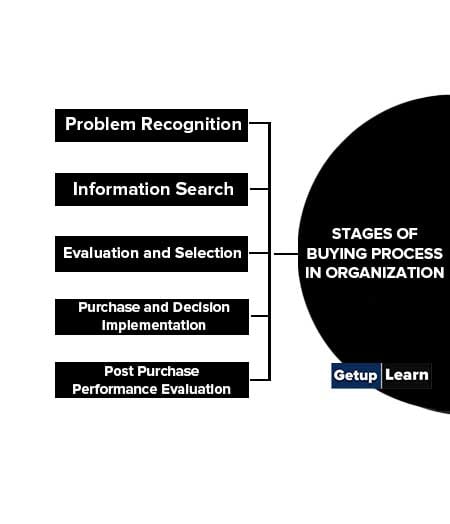
Problem Recognition
Like any other decision-making process, the first stage of the organizational buying decision process involves problem recognition, where one or more persons recognize a problem. It may occur under a variety of circumstances.
For example, the sales manager and office manager of an office play a key role in recognizing the need to add computers to their office. Recognition of this problem, however, can come up in several ways. In this particular instance, a continuing problem between field sales agents and internal administrative staff may lead the office manager and sales manager to recognize the problem.
The continuation of these sources of influence eventually leads to an increased level of importance and the subsequent stage of information search.
Information Search
Information search can be both formal and informal. Site visits to evaluate a potential vendor, laboratory tests of a new product or prototype, and investigation of possible product specifications are part of formal information searches.
Informal information search can occur during discussions with sales representatives, while attending trade shows, or reading industry-specific journals. Business buyers search for information both to help make the best decision and to support their actions and recommendations within the organization.
Evaluation and Selection
The evaluation of possible suppliers and selection of a supplier often follows a two-stage decision process. The first stage is making the buyer’s approved suppliers list. In this case, a conjunctive decision process is very common. Using this kind of process, the organizations screen out potential suppliers that do not meet all its criteria.
The second stage of organizational decision-making could involve other decision rules such as disjunctive and lexicographic etc. In the disjunctive decision rule, a minimum level of performance for each important attribute is established.
All brands that surpass the performance for any key attribute are considered acceptable. The lexicographic decision rule requires the business buyer to rank the criteria in order of importance. The buyer then selects the supplier/product that performs best on the most important attribute.
If two or more brands tie on this attribute, they are evaluated on the second most important attribute. This process is further complicated by the fact that different members of the decision-making unit have different evaluation criteria.
Purchase and Decision Implementation
Once the decision to buy from a particular organization has been made, the method of purchase must be determined. From the seller’s point of view, it means how and when they will get paid. In many cases, payment is not made until delivery. Others involve progress payments.
For a construction or builders’ firm that takes years, the method of payment is critical. On an international basis, purchase implementation and method of payment are even more critical.
Post Purchase Performance Evaluation
In the final stage of the business buying division process, the new product’s performance is evaluated. The product’s actual performance is compared to specifications and if necessary adjustments are made to the product that does not function as per expectations, the organization can ask the supplier to replace it.
At the same time, the supplier’s performance is also evaluated. If it is found to be unacceptable, the buyer will seek corrective action from the supplier or he will search for a new supplier.
What are the types of buying situations?
Following are the three types of buying situations:
1. New Task
2. Modified Rebuy
3. Straight Rebuy.
What are the characteristics of business markets?
These are the characteristics of business markets:
1. Fewer Buyers
2. Large Buyers
3. Supplier Customer Relationship
4. Geographically Concentrated Buyers
5. Derived Demand
6. Inelastic Demand
7. Fluctuating Demand
8. Professional Purchasing
9. Several Buying Influence
10. Multiple Sales Calls.
What is the difference between consumer market and business market?
These are the points of difference between consumer market and business market:
1. Fewer Buyers
2. Close Supplier-Customer Relationship
3. Geographically Concentrated Buyers
4. Derived Demand
5. Inelastic Demand
6. Professional Purchasing
7. Direct Purchasing.
Who are the participants in business decisions?
There are many participants in business decisions:
1. Users
2. Influencers
3. Buyers
4. Deciders
5. Gatekeepers.
What are the stages of buying process in organization?
The stages of buying process in organization are:
1. Problem Recognition
2. Information Search
3. Evaluation and Selection
4. Purchase and Decision Implementation
5. Post Purchase Performance Evaluation.

